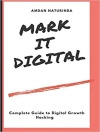Effectively engage your customers with the latest relationship marketing techniques
Managing the New Customer Relationship builds upon the foundations of customer relationship marketing (CRM) and provides practical methods and effective tools to help companies manage existing customer relationships, develop new ones organically, and grow their businesses. Companies have long recognized that current customers are their most profitable and that strategies are better focused on customer retention than acquisition. Relationship marketing, with all its complexity, requires new strategies, technology, and techniques.
Managing the New Customer Relationship provides effective solutions and wisdom in fostering good customer relations.
* Existing customers may be more forgiving and helpful when it comes to new ideas, cost management and testing new concepts
* Bundling goods and services or offer them through multiple channels can contribute to profitability, to accommodate customer inertia
* Existing customers can reduce marketing costs by using social media, replacing missionary selling with positive word-of-mouth
Your current customers are your best customers. And when you give them the attention they deserve in the most effective ways, you’ll watch your revenues grow faster than ever before.
Tabela de Conteúdo
Acknowledgments xiii
Introduction xv
Chapter One: Managing the New Customer–and the New Customer Relationship 1
Relationships Matter 1
The Old Rules of Marketing Don’t Work 3
Technology Has Changed Everything 6
The Truth Is Visible 6
Marketplaces Are Social 8
Marketing Is Sociology 9
One-Through-One Is More Important Than One-To-One 11
Defining the New Customer Relationship 12
Implications for Managing the New Customer Relationship 13
Chapter Two: Strategies for Better Customer Relationships23
A Strategic Context for Relationship Management 23
Relationship Management Capabilities 25
The Cultural Imperative 44
Beyond Culture: The Strategic Enablers 46
Chapter Three: Planning Relationships with Existing Customers57
What’s In a Relationship Management Plan? 57
Customer Selection 58
Relationship Objectives 76
Engagement 86
Value 92
Innovation 99
Teaching 102
Sharing 102
Chapter Four: One-Through-One: Engaging Social Customers107
The ‘Peoplescape’ of Social Media 108
The Company is No Longer Center Stage 109
The Customer is Speaking 110
Listen 111
Social Media Taxonomy 113
Social Media Objectives 115
Social Media Planning 118
Individual Customer Engagement 131
Chapter Five: B2B Relationships 141
Consumer and Business-to-Business Relationships 142
Buyer-Seller Relationship 150
Managing the B2B Relationship 152
B2B, Social Media and Product Lifecycles 153
Social, Internal to the Enterprise 158
Chapter Six: Relationships with Mobile Customers 163
Defining Mobile Relationships 164
Mobile Relationship Objectives and Strategies 166
Selected Application Categories for Mobile Devices 171
Emerging Technologies 181
Chapter Seven: Mass Customization 183
Mass Customization Defi ned 183
An Expensive Option? 184
Technology for Mass Customization 185
Enabling Relationships through Mass Customization 186
Approaches to Mass Customization 189
Customization versus Standardization 190
A Mass Customization Plan 191
Chapter Eight: Customer Analytics 199
The Meta is the Message 202
The Upside of Customer Analytics 205
Putting Customer Analytics to Work 208
Online Customer Analytics 216
Customer Analytics Soft ware 218
Customer Analytics and the Cloud 220
Net Promoter Score 221
Chapter Nine: Teaching Customers New Behaviors 223
What’s Wrong with Existing Customer Behaviors? 224
Pedagogy and Teaching Customers 226
Emotional/Affective Pedagogy 229
Cognitive Pedagogy 230
Behavioral Pedagogy 231
Individual/Social Pedagogy 232
Developing Pedagogy for Teaching Customers 236
Learning Relationships 238
Best Pedagogy Practices 239
From Teaching to Addicting 241
The Consumer as a Functional Addict 241
Chapter Ten: Case Studies: Making it Happen 255
Dell 256
Leicester City 259
New York City, Health and Human Services 261
Trans Gaming 265
Trans Link 270
Chapter Eleven: Strategy, Stakeholders and Semantics 275
Planning a Strategic Relationship 276
Customer Management 277
Direct and Indirect Stakeholders 279
Direct Stakeholder Management 280
Indirect Stakeholder Engagement 290
Strategic Response-ability 291
Society and Response-ability 292
Appendix A: Selected Customer Analytics/Data Mining Soft ware Solutions 297
Notes 303
About the Author 317
Index 319
Sobre o autor
Ian Gordon is a management consultant with over thirty
years of marketing and strategy experience. He is president of
Convergence Management Consultants in Toronto, Canada, where he
heads the Relationship Marketing-CRM practice, assisting clients to
develop customer acquisition and relationship management
strategies. He has worked with companies such as Alcan, Amadeus,
Apple, Bell Canada, Canada Post, Chrysler, Eastman Kodak, Ethyl,
Experian, Ford Electronics, General Electric, Goodyear, HP/Compaq,
IBM, Kodak Canada, Master Card, Microsoft, Mitel, NCR, Nortel
Networks, Ontario Power Generation, Parker Hannifin, RBC, Thomson
Reuters, Toshiba, Westinghouse and Xerox.
Ian is author of three previous books including the best-selling
Relationship Marketing: New Strategies, Techniques and
Technologies to Win the Customers You Want and Keep Them
Forever (John Wiley & Sons Canada, 1998). He was the
founding president of the Association for the Advancement of
Relationship Marketing, and a past president of the Industrial
Marketing and Research Association of Canada. He has lectured in
relationship marketing, CRM and other marketing courses to
undergraduate and MBA university students for over 20 years.












